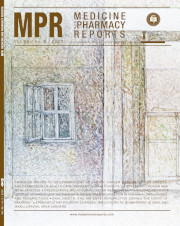Sarcopenia assessed by total psoas index – is it correlated with post-operative complications in all digestive cancers?
DOI:
https://doi.org/10.15386/mpr-2539Keywords:
sarcopenia, total psoas index, digestive cancer, post-operative complicationsAbstract
Background and aims. In cancer patients sarcopenia may be a predictor for postoperative complications of curative or palliative surgery. Several indices including the total psoas area index (TPAI) are proposed for the diagnosis of this condition, but there is no validated cut-off point.
Our study aimed to assess the role of TPAI as a marker for sarcopenia and to compare the utility of previously proposed cut-off values for predicting post-operative complications in patients with digestive cancers undergoing surgery.
Methods. We retrospectively included all adult patients with digestive cancers admitted to a tertiary center for elective surgery between January and December 2019. Sarcopenia was considered based on TPAI evaluated on abdominal computed tomography (CT) and for analysis we used different cut-off points published by various authors. The primary endpoint was the occurrence of any complications as defined by the Clavien-Dindo classification. The secondary endpoints were fistula development, low– versus high-grade Clavien-Dindo post-operative complications, moderate or severe anemia at discharge, major bleeding, hypoalbuminemia at discharge, and decrease in albumin levels by at least 1g/dL.
Results. We included 155 patients with a mean age of 64.78 ± 11.40 years, of which 59.35% were males; 58.06% developed postoperative complications. TPAI evaluated as a continuous variable was not a predictor for the development of post-operative complications neither in the general study sample, nor in the gender subgroups of patients. Sarcopenia defined by previously proposed cut-off values was not a predictor of the secondary end-points either.
Conclusion. TPAI as a sole parameter for defining sarcopenia was not a predictor for postoperative complications in patients undergoing surgery for digestive neoplasia.
Downloads
Published
How to Cite
Issue
Section
License
The authors are required to transfer the copyright of the published paper to the journal. This is done by agreeing to sign the Copyright Assignment Form. Whenever the case, authors are also required to send permissions to reproduce material (such as illustrations) from the copyright holder.

The papers published in the journal are licensed under a Creative Commons Attribution-NonCommercial-NoDerivatives 4.0 International License.

